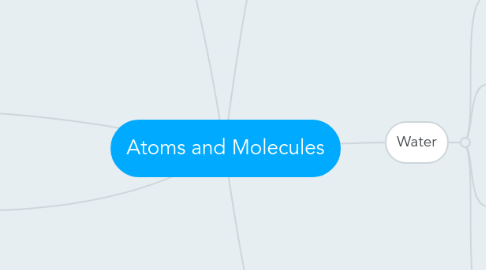
1. Elements
1.1. 92 naturally occuring elements
1.2. Periodic Table
1.3. Common Elements
1.3.1. Hydrogen
1.3.2. Helium
1.3.3. Carbon
1.3.4. Nitrogen
1.3.5. Oxygen
1.3.6. Sodium
1.3.7. Magnesium
1.3.8. Phosphorus
1.3.9. Sulfur
1.3.10. Chlorine
1.3.11. Potassium
1.3.12. Calcium
1.3.13. Iron
2. Molecules
2.1. Two or more atoms bound together
2.2. Compounds
2.2.1. Molecules formed of different atoms
3. Atoms
3.1. Atom Composition
3.1.1. Atomic Nucleus
3.1.1.1. Contains neutrons and protons
3.1.1.2. Stable (ex. Carbon atoms cannot turn into magnesium)
3.1.2. Fundamental Particles
3.1.2.1. Neutrons
3.1.2.1.1. Neutral charge
3.1.2.1.2. Dictate isotope
3.1.2.2. Electrons
3.1.2.2.1. Negatively charged
3.1.2.2.2. Orbit nucleus
3.1.2.2.3. Lighter than protons and neutrons
3.1.2.3. Protons
3.1.2.3.1. Positively charged
3.1.3. Electron Shell
3.1.3.1. Two electrons in first shell
3.1.3.2. Second and third shell can hold eight
3.2. Atom Interaction
3.2.1. An atom will not react with another atom when its outermost electron shell is completely full or empty. (Inert atom)
3.2.2. An atom will react with other atoms when its outer-most electron shell is only partially full. (Reactive atom)
3.3. Free Radicals
3.3.1. Aspects
3.3.1.1. Unstable
3.3.1.2. Captures electrons to fill shell
3.3.1.3. Steals electron
3.3.1.3.1. Creates new free radical
3.3.2. Consequences
3.3.2.1. Cell death
3.3.2.2. Cancer
4. Chemical Aspects
4.1. Holds together atoms
4.2. Chemical bonds
4.2.1. Bonds
4.2.1.1. Ionic Bonds
4.2.1.1.1. Attraction of negatively and positively ions
4.2.1.1.2. Ions
4.2.1.2. Covalent Bonds
4.2.1.2.1. Aspects
4.2.1.2.2. Nonpolar covalent bond
4.2.1.2.3. Polar covalent bond
4.2.1.3. Hydrogen Bonds
4.2.1.3.1. Water molecules attracted to each other
4.2.1.3.2. Positive (Hydrogen) to negative (Oxygen) ends
4.3. Chemical reactions
4.3.1. Making and breaking of bonds
5. Water
5.1. Hydrophillic
5.1.1. Dissolve easily in water
5.1.2. Ions and polar molecules
5.2. Hydrophobic
5.2.1. Disrupt nearby hydrogen bonds
5.2.2. Form globules
5.2.3. Hydrophobic interaction
5.2.3.1. Tendency of hydrophobic molecules to clump together
5.3. Aspects
5.3.1. Cohesion
5.3.1.1. Molecules that tend to stick together
5.3.1.2. Surface tension
5.3.1.2.1. resistance for water to break cohesion
5.3.2. Adhesion
5.3.2.1. Allows water to move in small spaces
5.3.2.2. Tendency to stick to polar surfaces
5.4. Ice
5.4.1. Less dense than water
5.4.2. Allows top of lake to freeze
5.4.2.1. Water does not freeze to bottom of lake
5.4.2.1.1. Underwater organisms can live under ice
6. pH
6.1. Aspects
6.1.1. Degree of acidity
6.1.2. pH Scale
6.1.2.1. Logitrithmic
6.2. Acids
6.2.1. pH greater than 7
6.2.2. Donates ions
6.3. Bases
6.3.1. pH less than 7
6.3.2. Accepts ions
6.4. Neutral
6.4.1. pH exactly 7
6.5. Buffer
6.5.1. Does not easily change pH
6.5.2. Accepts and donates ions at constant rates
